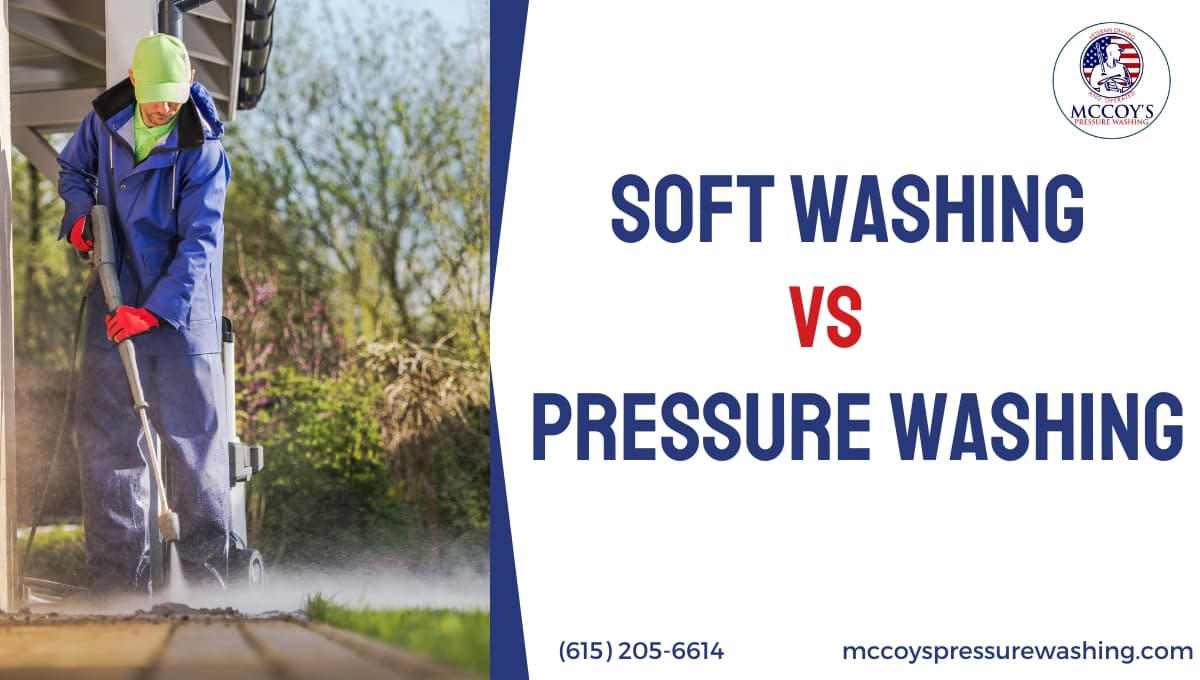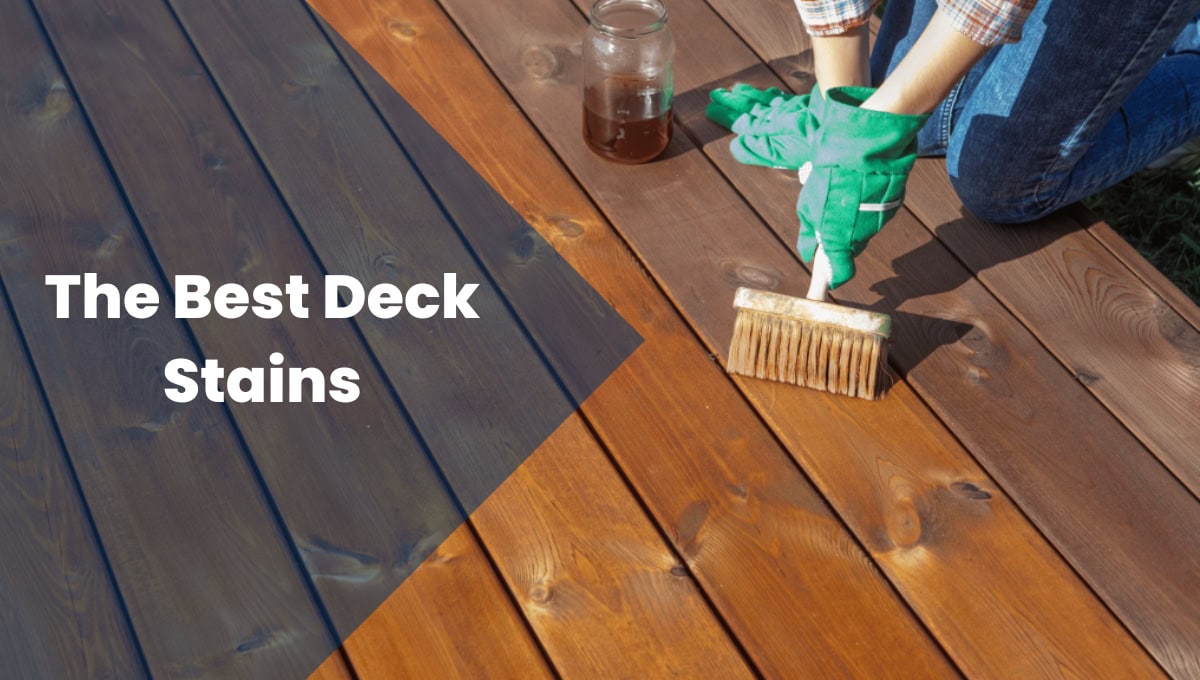When it comes to cleaning the exterior of your home, choosing between “soft washing vs pressure washing” is an important decision. The effectiveness and safety of the cleaning process are at stake. In this blog, we will explore the details of each method to help you make the right decision for your cleaning requirements.
What is Soft Washing?
Soft washing is a gentle and sophisticated technique for cleaning exterior surfaces without causing any structural damage. This nuanced approach caters to delicate materials that require a finesse-driven cleaning process.
Soft washing operates at a pressure level typically below 1,000 PSI, making it the perfect choice for revitalizing various surfaces without harming their structure. Unlike high-pressure washing, soft washing is a refined and gentle technique that can breathe new life into delicate materials.
How Soft Washing Works?
Soft washing is a highly effective cleaning technique that uses low-pressure water and specially formulated cleaning solutions. Let’s take a look at the step-by-step process involved in soft washing:
Equipment: Soft washing is a cleaning method that uses a special pump sprayer that operates within a pressure range of 150 to 300 PSI.
Pressure application: The low-pressure application ensures a gentle cleaning process.
Cleaning agents: The cleaning solution used in soft washing is biodegradable and contains sodium hypochlorite, sodium hydroxide, algaecides, and surfactants.
Contaminant removal: Soft washing targets and eliminates various contaminants, including mold, mildew, algae, pollen, dirt, moss, and oil or grease.
Synergistic action: The cleaning solutions work together to effectively break down and eradicate contaminants.
Neutralizers: Neutralizing agents minimize potential harm to plants and the environment.
Thorough cleaning: Soft washing precisely addresses specific contaminants, resulting in a comprehensive and meticulous cleaning process.
Pros and Cons of Soft Washing
| Soft Washing | Pros | Cons |
| Method | Gentle and effective cleaning method | Slower cleaning process |
| Surface Suitability | Ideal for delicate structures and surfaces | May not remove certain stains, like embedded dirt |
| Operational Ease | Easy to manage with lower risks | May require multiple rounds of cleaning |
| Environmental Impact | More environmentally friendly with less water usage | Slower cleaning process compared to pressure washing |
| Cleaning Solutions | Utilizes various chemicals like bleach, surfactants, etc. | Some stains may require the power of a pressure washer |
| Protection | Curbs harmful growth, preventing mold and algae | |
| Damage Risk | Low risk of damage to surfaces | Slower cleaning process |
What is Pressure Washing?
Pressure washing is a highly effective technique for cleaning exterior surfaces, often confused with power washing. While the terms power washing vs pressure washing are sometimes used interchangeably, they have subtle differences. Power washing typically uses heated water to enhance cleaning, making it ideal for removing grease or oil, while pressure washing relies on unheated, high-pressure water spray to tackle dirt, grime, and other contaminants.
Pressure washing operates with water pressures ranging between 1,300 to 2,800 PSI, making it particularly useful for removing tough stains and resilient grime in various scenarios. Electric or gas-powered pressure washing equipment generates the necessary force, making it an excellent choice for cleaning hard surfaces like concrete, patios, and sidewalks. Its higher PSI compared to soft washing ensures a more vigorous cleaning process for surfaces requiring robust treatment.
How Pressure Washing Works
Pressure washing is a powerful cleaning process that uses high-pressure water to remove dirt, grime, and contaminants from various surfaces. For those new to this method, understanding a pressure washing setup for beginners can help ensure safe and effective use. Here’s a breakdown of how pressure washing works:
Equipment: It uses a pressure washer, which sprays water at a forceful rate, typically ranging from 1,300 to 2,800 PSI, depending on the cleaning requirements.
Operation: During the process, a nozzle expels water at an accelerated pace, allowing it to penetrate and break down stubborn stains, mold, mildew, and other contaminants. Unlike soft washing, which requires additional cleaning solutions, pressure washing primarily relies on the sheer force of water.
Effectiveness: Pressure washing is effective for cleaning robust surfaces, such as stone, asphalt driveways, garage floors, sidewalks, patios, and treated wooden decks. The forceful stream of water efficiently dislodges and sweeps away accumulated dirt, making it suitable for tasks that demand a more vigorous cleaning approach.
Pros and Cons of Pressure Washing
| Pressure Washing | Pros | Cons |
| Method | Quick and efficient cleaning method | May cause damage to delicate surfaces |
| Surface Suitability | Suitable for robust and less porous materials | Difficult for beginners, best avoided on fragile surfaces |
| Operational Speed | Speedy cleaning process | Can’t be safely used on all surfaces |
| Cleaning Power | Can remove most stains | High risk of causing damage, especially in inexperienced hands |
| Versatility | Ideal for strong surfaces like concrete | Some surfaces may need a more delicate approach |
| Environmental Impact | Quick process reduces overall water usage | Potential damage and environmental impact due to high pressure |
Soft Washing vs Pressure Washing: Choosing the Right Method

Soft washing and pressure washing are two methods of cleaning a home’s exterior, and choosing the right one is essential. Power washing involves using high-pressure water spray to remove tough stains, grease, and grime from sturdy surfaces like brick, concrete, metal, hardwood, and aluminum. On the other hand, soft washing uses a more gentle pressure range of 150-300 PSI to clean fragile surfaces like vinyl siding, cedar shake siding, wood siding, roofs, and more.
Combining power and soft washing can be a useful approach to cleaning exteriors, as it leverages the strengths of each method. Soft washing is ideal for surfaces vulnerable to high-pressure damage. In contrast, power washing is best for robust surfaces that require a more forceful approach. This targeted application of power and soft washing ensures a thorough and safe cleaning process and preserves the integrity of different surfaces.
When using cleaning methods, it is essential to consider the surface variability. A typical home has different materials, such as vinyl siding and a concrete driveway. Therefore, it is necessary to apply each technique selectively and appropriately to ensure precision and a thorough cleaning process.
When to Use a Soft Wash
Soft washing is the better option for cleaning delicate or porous surfaces that could be damaged by high-pressure water. This method uses biodegradable cleaning solutions and a low-pressure stream, making it safe and effective for sensitive areas. Consider soft washing for the following applications:
- Roof Cleaning: Safely removes algae, moss, and mildew without risking shingle damage.
- Vinyl Siding and Stucco: Cleans dirt, mold, and grime without harming fragile exteriors.
- Wood Siding and Fences: Gently revitalizes natural wood without splintering or cracking.
- Painted Surfaces: Ideal for maintaining painted surfaces without chipping or peeling the paint.
- Windows and Screens: Removes dirt and streaks while preventing cracks or damage.
When to Use Pressure Washing
Pressure washing is the best choice for cleaning sturdy, hard surfaces that can withstand high water pressure. The force of the water is ideal for tackling tough stains, grime, and dirt on surfaces that don’t require a delicate touch. Use pressure washing in the following scenarios:
- Concrete Driveways and Sidewalks: Effectively removes oil stains, tire marks, and embedded dirt.
- Patios and Decks: Ideal for cleaning treated wood, stone, or concrete patios.
- Brick and Masonry: Perfect for clearing grime and mildew from bricks or other non-porous materials.
- Garage Floors and Parking Areas: Quickly removes grease, spills, and stains.
- Outdoor Furniture and Equipment: Cleans weathered and grime-covered outdoor items made of metal or other durable materials.
Contact Best Cleaning Service Provider for Your Home
Successfully using pressure and soft washing techniques requires expertise and precision. McCoy’s is skilled in both methods, allowing us to create customized cleaning strategies tailored to your home’s unique needs. With our expertise, we deliver optimal results that preserve your property’s integrity and ensure it remains pristine for years to come.
We proudly offer our pressure washing services in Murfreesboro, Smyrna, Franklin, Brentwood, Lebanon, and surrounding areas. Whether your home’s exterior needs a gentle touch with soft washing or a powerful clean with pressure washing, our team guarantees exceptional results.
Transform the look of your home with McCoy’s Deck Staining and Pressure Washing. Call us today at 615-290-6013 for a free estimate and let us help your property shine like never before!
FAQs on Soft Washing vs Pressure Washing
Can you softwash with a pressure washer?
Yes, you can softwash with a pressure washer. Soft washing typically involves lower pressure, so you could adapt a pressure washer for soft washing by using appropriate nozzles and adjusting pressure settings.
Can power washing and soft washing be used together?
Absolutely. Professionals often use a combination of power washing and soft washing techniques to address different cleaning needs on a property.
What chemicals do you use for soft washing?
Soft washing chemicals include bleach, surfactants, neutralizers, and odor removers to clean surfaces effectively without causing damage.
Is soft washing cheaper than pressure washing?
The cost of soft washing and pressure washing can vary, but both methods are generally comparable. The choice depends on your specific cleaning requirements.
Find the cost of pressure washing a house in our blog.
Is soft washing better than pressure washing?
The effectiveness of soft washing vs pressure washing depends on the surfaces you’re cleaning. Soft washing is gentler and ideal for delicate materials, while pressure washing is more robust and suitable for strong surfaces.




